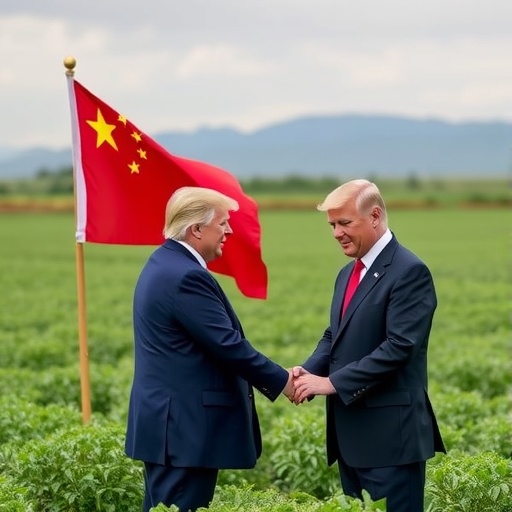Trump Administration Secures Framework with China: Averting Tariffs and Revitalizing U.S. Agriculture Exports
In a pivotal move that could reshape global trade dynamics, the Trump administration has hammered out a preliminary framework agreement with China, staving off a fresh wave of tariffs while pledging significant boosts to U.S. agricultural exports. Treasury Secretary Scott Bessent revealed the deal during a press briefing in Washington, D.C., emphasizing its role in protecting American farmers and fostering economic stability amid escalating tensions. As President Trump gears up for a high-stakes summit with Chinese President Xi Jinping in Korea next month, this development signals a potential thaw in U.S.-China relations, with agriculture at the forefront of renewed cooperation.
The framework, described by Bessent as “substantial and actionable,” comes at a critical juncture. Just weeks ago, whispers of impending tariffs on Chinese goods had U.S. farmers on edge, fearing another blow to their already volatile markets. Now, with commitments from Beijing to ramp up purchases of American soybeans, corn, and pork, the deal offers a lifeline to rural economies battered by previous trade skirmishes.
Treasury Secretary Bessent Details the Core Elements of the Trade Framework
Treasury Secretary Scott Bessent, a key architect of the administration’s economic strategy, stepped up to the podium at the White House to outline the framework’s pillars. “This isn’t just talk; it’s a concrete path forward that prioritizes American interests,” Bessent declared, flanked by agricultural experts and trade negotiators. The agreement explicitly halts the imposition of new tariffs on over $300 billion in Chinese imports, a measure that President Trump had threatened as leverage in ongoing disputes over intellectual property and market access.
At its heart, the deal focuses on agriculture, with China agreeing to increase its annual purchases of U.S. farm products by at least 20% over the next two years. This translates to an estimated $15 billion in additional exports, according to preliminary figures from the U.S. Department of Agriculture (USDA). Soybeans, a staple in Chinese animal feed, top the list, with commitments for 10 million metric tons more than last year’s volumes. Corn and wheat follow suit, addressing a surplus that has plagued Midwest farmers since the 2018 trade war escalated.
Bessent highlighted the reciprocity baked into the framework: In exchange for tariff relief, China must dismantle non-tariff barriers that have long hindered American agribusiness. These include stringent biotech approvals and opaque quarantine rules that delayed shipments and inflated costs. “We’re not asking for favors; we’re demanding fair play,” Bessent added, quoting President Trump’s longstanding mantra on trade fairness.
To ensure compliance, the framework incorporates monitoring mechanisms, including quarterly reviews by a joint U.S.-China task force. Early indicators are promising; USDA data shows a 5% uptick in soybean futures prices since rumors of the deal surfaced last week, signaling market confidence in the Trump administration’s negotiation prowess.
U.S. Farmers Reap Immediate Benefits from Tariff Aversion
For American farmers, the news couldn’t come soon enough. The agricultural sector, which contributes over $1.2 trillion to the U.S. economy annually, has been a flashpoint in U.S.-China trade relations. During the first Trump term, tariffs imposed by both sides led to a 74% drop in U.S. soybean exports to China in 2018, forcing farmers to seek alternative markets in Europe and Southeast Asia at lower prices. Billions in federal aid cushioned the blow, but the uncertainty eroded rural livelihoods and fueled political divides.
Under this new framework, the Trump administration projects that avoiding tariffs will save U.S. exporters up to $10 billion in potential duties, freeing up capital for innovation and expansion. “This deal puts money back in farmers’ pockets,” said National Farmers Union President Rob Larew in a statement. “It’s a win for the heartland that we’ve been fighting for.”
Take Iowa, for instance—a state where agriculture employs one in five workers. Local co-ops report that the pledged increase in Chinese purchases could add $2 billion to the state’s economy alone. Pork producers in North Carolina, still recovering from African swine fever outbreaks in China that slashed demand, stand to gain from renewed access. The framework also includes provisions for expedited veterinary approvals, potentially cutting shipment delays from months to weeks.
Statistics underscore the stakes: China imports about 60% of the world’s soybeans, and the U.S. supplies roughly 30% of those. Restoring that flow could stabilize prices, which have hovered 15-20% below pre-trade war levels. Environmental advocates, however, caution that ramped-up production might strain water resources in the Corn Belt, prompting calls for sustainable farming incentives within the deal.
Personal stories amplify the human element. Jim Johnson, a third-generation soybean farmer from Illinois, shared his relief in an interview with AgriNews: “We’ve been hanging on by a thread. This framework means I can plan for next season without fearing another tariff bomb.” Such narratives highlight how the trade deal transcends economics, touching on family legacies and community survival.
Intense Negotiations Pave Way for U.S.-China Thaw
The path to this framework was anything but smooth, involving months of clandestine talks between U.S. and Chinese envoys. Negotiations kicked off in neutral Geneva last spring, escalating to virtual sessions amid pandemic recovery efforts. Key sticking points included China’s state subsidies for its own farmers, which the U.S. views as unfair competition distorting global prices.
President Trump himself played a hands-on role, reportedly holding late-night calls with Xi to build personal rapport. Sources close to the White House describe a “delicate dance,” where Trump leveraged his unpredictable style to extract concessions. In one notable exchange, Trump quipped during a video summit, “Tariffs are like a bad haircut—they hurt until you fix them,” according to a leaked memo, lightening the mood and advancing discussions.
China’s perspective, articulated by Vice Premier Liu He in Beijing, frames the agreement as mutually beneficial. “Enhancing agricultural imports from the U.S. supports our food security while strengthening bilateral ties,” Liu stated in an official release. This aligns with Beijing’s push to diversify supply chains post-COVID, reducing reliance on volatile international markets.
Broader context reveals the deal’s geopolitical weight. With U.S. midterm elections looming, Trump positions this as a foreign policy triumph, contrasting it with the Biden era’s perceived inaction on trade imbalances. Critics, including Senate Minority Leader Chuck Schumer, argue it’s a short-term patch: “A framework is no substitute for a full trade deal; we need enforceable commitments, not promises.”
Yet, the negotiations’ success owes much to third-party facilitation. South Korea, host to the upcoming summit, offered discreet mediation, drawing on its own trade expertise. Historical parallels abound—from the 1972 Nixon visit that opened China to the 2019 Phase One deal under Trump, which this framework builds upon by addressing agriculture lapses.
Summit Spotlight: Trump and Xi Set to Seal the Deal in Korea
All eyes now turn to Busan, Korea, where President Trump and President Xi are slated to convene in early November. Billed as the “Pacific Prosperity Summit,” the event will feature bilateral talks alongside multilateral discussions on supply chains and climate. For Trump, it’s an opportunity to showcase diplomatic wins; for Xi, a chance to project stability amid domestic economic headwinds.
Agenda items extend beyond agriculture: Expect debates on technology transfers and currency manipulation, with the tariff suspension as a goodwill gesture. Security experts anticipate side deals on rare earth minerals, vital for U.S. tech and defense sectors. “This summit could redefine the next decade of U.S.-China engagement,” noted Brookings Institution analyst Yun Sun.
Logistics are underway, with Air Force One preparations and enhanced security protocols. Korean officials, neutral yet invested, have prepared venues emphasizing harmony—a nod to the summit’s trade focus. Public anticipation is high; polls show 62% of Americans view improved China ties favorably if they benefit workers, per a recent Pew survey.
Stakeholders from agribusiness giants like Cargill to smallholder associations are lobbying for inclusions. The framework’s success hinges on summit outcomes; failure could reignite tariff threats, but success might unlock further sectors like energy and manufacturing.
Global Ripples and Future Horizons for Trade Stability
As the dust settles on this framework, its implications ripple worldwide. For U.S. agriculture, the boost could spur investments in precision farming and export infrastructure, potentially creating 50,000 jobs over five years, per USDA estimates. Internationally, it eases pressure on global food prices, which spiked 28% in 2022 due to trade disruptions.
Trade partners like Brazil and Argentina, major soybean rivals, face recalibrated competition; their exports to China may dip, prompting diversification. In Washington, the deal bolsters Trump’s narrative of economic nationalism, influencing policy on issues like the USMCA review.
Looking ahead, experts foresee iterative progress: A full trade deal by 2025, incorporating digital trade and environmental standards. Challenges persist—enforcement gaps and domestic politics could derail gains—but optimism prevails. “This framework is a foundation, not a finish line,” Bessent concluded. With the Korea summit on the horizon, the Trump administration’s gamble on dialogue over confrontation may yield enduring dividends for American prosperity.
In the broader economy, stabilizing U.S.-China trade could add 0.5% to GDP growth, according to Moody’s Analytics, underscoring the high stakes. Farmers’ groups are already planning advocacy pushes, while investors eye opportunities in ag-tech. As negotiations evolve, one thing is clear: The Trump-China trade deal is poised to influence everything from farm fields to boardrooms, marking a tentative step toward equilibrium in an interconnected world.








